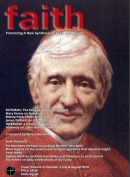The New (corrected) ICEL Translation
Tim Finigan FAITH Magazine September – October 2011
Fr Timothy Finigan, Parish Priest of Blackfen, sketches the slow process, following Christopher Monckton's 1979 expose in this magazine, of correcting the 1970s mistranslation of the text of the liturgy. He also touches upon the opportunities offered by the translation for healing some of the deep ecclesial wounds of recent decades. Fr Finigan has a popular blog, The Hermeneutic of Continuity.
People have grown old and died waiting for an accurate English translation of the Missal of Pope Paul VI. Most Catholics under 40 years of age have never been able to participate at Mass said according to a faithful rendering of the official Latin text. This injustice to the People of God is now being rectified, and not before time.
The imprimatur for the first full ICEL Missal in England was given by Cardinal Heenan in October 1974. The introduction of the whole Missal was not necessarily immediate. In England and Wales, the former, and much better translation of the National Liturgical Commission (NLC), known colloquially as the "Wheeler Missal" after Bishop Wheeler who played a significant part in producing it, remained legitimate as an alternative. In the September-October 1975 issue of Faith Magazine, Fr Holloway wrote: "To my mind, it is a blessing that our Bishops have not yet allowed ICEL complete and total dominion, although for how long can NLC hold out?" In fact, it did gradually fall into general disuse, although some priests carefully retained copies of the Wheeler Missal. In recentyears, they have become as gold dust for younger clergy. (It is still legitimate, I suppose, until the first Sunday of Advent, though I wonder whether anyone has even remembered to mandate its suppression.)
Early Criticisms of the Old ICEL
Though the NLC Propers could be used, the Ordinary of the Mass had to be ICEL. Criticisms of ICEL in the early days therefore often focussed on the texts of the Creed or the Eucharistic Prayers. Even so, this was in the days long before the first web browser was invented, and the reaction was slower than we are accustomed to now. People did complain about the translation, focussing on its banality and lack of a sense of the sacred. Latin Mass (even in the new rite) had become a rarity by the mid 1970s and so it required an effort to get hold of a Latin Missal to compare the texts. As more and more interested Catholics did so, there was a sense of outrage at what was missing, changed or simply invented. In 1979, Christopher Monckton, then Editor of the Universe, focussed the complaints ofmany of us in his widely influential paper for the Association of English Worship, published in this magazine (Dec 1979) as "Caught in the Act. A Conspiracy of Errors." (He compiled a list of over 400 such errors.)
The main point of his article was that the ICEL translation (of the Ordinary of the Mass) was not only banal, nor even simply erroneous; Monckton demonstrated that it was marred by systematic omissions, and systematic doctrinal defects. The words sanctus and beatus had been passed over in almost every place where they occur in the text. As he observed, "there was only one point at which the translators must have found it all but impossible to omit the word "Sanctus" and that is in the SANCTUS itself." They could hardly have expected the priest and people to say: "\_\_\_\_,\_\_\_\_,\_\_\_\_," My own favourite example of desacralising is the translation of the text in the Roman Canon "accipiens et hunc praeclarum calicem in sanctas et venerabiles manus suas" which is properlytranslated in the new ICEL as "he took this precious chalice in his holy and venerable hands." The old ICEL has "he took the cup."
Monckton also drew attention to the theologically grave problem of the text's playing-down of sacrificial language, eliminating the distinction between the offering made by the priest and that made by the people, and losing the notion of Christ as victim. The most glaring example is the phrase ''sanctum sacrificium, immaculatam hostiam" in the Roman Canon, which is simply omitted.
Ever since Monckton's article and others like it in the late seventies, it has been an open secret that the translation was bad, and needed to be replaced. Even at that time, with the text not six years old, the Chairman of ICEL indicated that it was to be subject to a careful and painstaking re-evaluation; it took eighteen years for a new text to be presented to the Holy See. By 1998, however, many things had changed: Pope John Paul's papacy had matured, and the Congregation for Divine Worship, after a series of other good prefects, was now run by Cardinal Estevez. In his letter to ICEL, the Cardinal gave 114 examples of specific flaws in the proposed text, saying that the list "cannot be considered in any way exhaustive." He specifically noted "It appears, indeed, consciously orunconsciously to promote a view of sacramental and ecclesiological theology that contrasts with the intentions of the Holy See." Among the many defects, he noted the dropping of the words sanctus and beatus: the "careful and painstaking" eighteen year re-evaluation did not seem to have achieved very much.
Before offering his cordial good wishes in Christ the Lord, Cardinal Estevez wrote:
"... this Congregation considers it may be helpful to recommend that there be a complete change of translators on this project and that a new, independent and definitive English version be made afresh from the Latin texts."
Not long afterwards, in 2001, the instruction Liturgiam Authenticam was issued, insisting that
"the original text, insofar as possible, must be translated integrally and in the most exact manner, without omissions or additions in terms of their content, and without paraphrases or glosses. Any adaptation to the characteristics or the nature of the various vernacular languages is to be sober and discreet."
The following year, ICEL was reconstituted with due acknowledgement of the competence of the Congregation for Divine Worship, and the process of translation began for a third time. The growing use of the internet, especially in social networking, meant that through the debates of the US Bishops' Conference (commendably held in public session) the general Catholic public became increasingly aware of just what thinking was behind what was coming to be known by consensus as the "lame-duck translation", an expression popularised by Fr Zuhlsdorf who has spent many years analysing "What does the prayer really say?" both in his column for The Wanderer and on his popular blog. When Bishop Trautman of Erie complained about unfamiliar words being used, bloggers jokingly vied with eachother to include the words "ineffable", "wrought" and "gibbet" into ordinary posts. The opposition to the more sacral language was characterised as objecting to "them fancy words."
A Great Relief for Priests and People
Now, after several decades, we finally have an accurate translation of the Roman Missal to use for the celebration of Mass. During the lead-up to its introduction, some of the liberal Catholic press has been acting in a way reminiscent of the "phony war" of 1939. They have not been issuing gas masks and practising air raid drills, but from the hysteria of some articles, you would think that extra first-aiders should be trained. I am not exaggerating here. The Tablet actually posted an article on its website in which the author suggested that asking children to say in The Confiteor "through my fault, through my fault, through my own most grievous fault" while beating their breasts, was a form of psychological child abuse. Wisely (perhaps realising that this foolishcomment trivialised real child abuse) The Tablet took the article down.
Most ordinary Catholics who are still actually going to Mass will not be troubled by the changes to the text, except for stumbling a bit for the first few weeks and accidentally falling into the old ICEL from time to time. The priest can do a lot to help in the reception of this change. If he is obviously enthusiastic and positive, the people will be encouraged in their faith, and can benefit from the catechesis that he gives in his ordinary preaching, looking at topics like sacrifice, grace, humility, and the sacredness of the Liturgy, to give a few examples of doctrines that show out much more clearly in the new texts.
For the minority who take an active interest in the Liturgy, read Catholic articles and follow news within the Church, I suspect that the people who are delighted by the new ICEL will far outnumber those who are opposed to it. For priests who are faithful to the Church, and have been aware of the errors and deficiencies of the old ICEL, it will be a relief and a joy to be able to use a worthy text for the celebration of Mass in English. For the 27 years of my priestly life, I have been using a lame-duck text that dumbs down the theology of the Mass and prevents me from giving to God the reverence due to Him in the words of the prayers prescribed by the Church. I rejoice that the students I have taught, who are being ordained this year will begin their priestly ministry with a worthytext.
Unfortunately, there has been little progress on the question of copyright to the text, which belongs to the local Bishops' Conferences. The cards which have been produced by the major publishers have various problems because of conditions imposed by the National Liturgical Committee. They imply or state that the offertory prayers must be said out loud, that the sign of peace is compulsory, and that Holy Communion must be received standing. They are also unwieldy because of ICEL's insistence that the texts must be printed according to "sense lines." (This constraint also make the Missal itself waste acres of white space.) Last year, when the "phony war" ponderously urged elaborate preparation for priests to be able to use the new texts, I pointed out at one clergy meeting that I had donethe preparation many years ago by taking English O-Level. The stubborn insistence on "sense lines" is surely a form of that "infantilisation" which was fostered by the collaborative ministry enthusiasts but is so decried nowadays.
Paradoxically, since Summorum Pontificum, it is easier to obtain high quality pdfs of the texts and music for the extraordinary form of the Mass and the Divine Office than for the ordinary form in English. There will undoubtedly be an underground movement to share electronic versions of the text so that booklets and leaflets can be produced and distributed on the internet free of charge. (There is already a text of the newly-translated Missal available on Wikispooks) It would make sense for ICEL and the English speaking Bishops' Conferences (or any one of them) or the Holy See itself to put an official version of the text out into the wild under a licence that allowed non-commercial copying with the caveat that the text itself should not be modified (it is in fact mucheasier to verify the integrity of an electronic text.) Hunting people down for copyright violations is a waste of time that could be better spent supporting the work done by enthusiastic Catholics free of charge for the love of God.
In a way, the liberals are right to fear the new (corrected) ICEL text. They do not want any change in the status quo because it will inevitably provide an opportunity to make other changes, most notably to the music that is used for the Mass. If parishes begin to recover the idea of a sung Mass, rather than a Mass at which things are sung, that will be a great improvement to the celebration of the Liturgy. Once bumped out of the groove in which we have been stuck for decades, it will be easier for parish priests to take up some of the reforms which have been encouraged gently by Pope Benedict, to be frightened no longer by traditional vestments and vessels for Mass, by the possibility of at least some celebrations of Mass being ad orientem, or by gently moving away fromanti-liturgical informality.
During the decades in which we have been lumbered with the lame-duck translation, much has changed in the Church: some of the changes have ironically been a matter of people continuing to do the same thing. Those who as youngsters were attracted by the folk choir and have remained in it, can sometimes now look like the ageing rockers who play at teatime in seaside pavilions in the summer. They may still harbour the pious hope that young people will be attracted by matey liturgy and jolly tunes. The sad reality is that in most parishes there are hardly any young people left after the Confirmation course has finished. The ones who do remain will stay because either through a miracle or the providence of God they have received some formation in the faith: they want the truth and they want toworship God. Some school chaplains or diocesan youth centres have tried hard to move towards better and more catechetical music for worship but the danger remains that this is of transient appeal and can become quickly outdated and a source of amusement unlike the perennial sacred music of the Church which was actually mandated by Vatican II.
The debate over whether liturgy or catechesis is most important for saving the faith of the young has taken a new turn in the recent revival of the Liturgical movement. The Liturgy has been rediscovered as itself a source for theology, and therefore also for catechesis. This certainly does not mean that the Liturgy is primarily a school assembly: making it such is one of the problems that we have to overcome. Rather, the priest in his preaching, and the catechist in sacramental preparation can use the texts of the Liturgy to illustrate the faith. This will be much easier with the new (corrected) translation which succeeds in preserving the dogmatic content of the prayers. Shortly after the time of the publication of the lame-duck translation, Faith movement produced a pamphletcalled "The Liturgy: a catechism of Catholic doctrine." This showed that even in what was a bad translation, the basic doctrines of the faith could be found in the text. Now everyone is talking about the opportunity for catechesis that the new text presents.
Important though this is, it must be accompanied by a recovery of the sacred in the Liturgy: especially in the celebration of Sunday Mass, and even more crucially in the celebration of the school Mass. Many active young Catholics have found the numinous in the usus antiquior and have become attached to it, much to the bewilderment of older Catholics who remember the heady days of the seventies with nostalgia. Whatever the process of mutual enrichment between the Extraordinary and Ordinary Forms of Mass (as desired by Pope Benedict) will hold for the future, the present position of young Catholics is that they are going to keep or lose the faith through what they experience in the Mass celebrated at their parish and at their school. The new (corrected) translation offers us adefinitive moment of action (the local centre of spirituality would doubtless call it kairos.) Archbishop Nichols told the clergy of Westminster on the 9th of June last, that "the Liturgy forms us, not us the Liturgy." I agree with him and would add that right now, we need to seize the opportunity to change more than simply the translation: clergy of orthodox faith who love the Church must take the risk of insisting that they will submit themselves to the Liturgy, eradicate informality, correct abuses and (if not literally then at least symbolically) turn towards the Lord. Whether in English or in Latin, we are in fact going up to the altar of God. And He is the one who gives joy to our youth.





